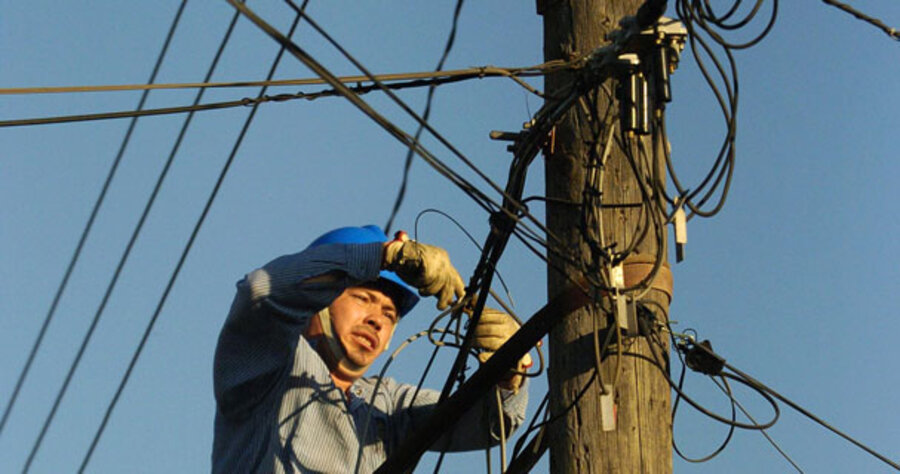Why do so many Americans have crummy Internet speeds?
A decade ago, I lived in a small town in Nova Scotia while working for csmonitor.com. Windsor had a population was about 3,500 and I don’t imagine it’s grown much since then. But even back then, I had high-speed broadband access, which at the time was almost unheard of in Boston. In fact, I used to joke with my Monitor co-workers that it was hard to visit them in Massachusetts because it meant my Internet speeds slowed down so much.
While broadband access has grown in the United States over the past 10 years, it’s not as dramatic as you might think it is based on the TV commercials and direct-mail flyers trumpeting high-speed access.
In fact, a new report by the Organization for Economic Cooperation and Development (OECD) shows that the US ranked 15th out of 30 developed nations in 2007 when it comes to broadband penetration – a drop of three places from 2006. While the US has the largest number of broadband subscribers – about 70 million – only 23 percent of Americans subscribe to broadband.
The report also shows that Americans pay more, on average, for broadband connections than residents in 21 other OECD countries – and those connections run at slower advertised speeds than 13 other countries. In other words, the performance of US broadband service is pretty mediocre.
In the past, defenders of US broadband performance have argued that countries with a higher population density – more people living in closer quarters – have an easier time rolling out broadband services.
Well, as the guys on Car Talk would say, “Boooogus.” Five countries with lower population densities than the US – Canada, Sweden, Finland, Norway, and Iceland – are beating the US when it comes to broadband penetration, the report says.
But it’s not just broadband itself where the US is lagging behind much of the rest of the developed world. The next big step in broadband is fiber-to-the-home networks. Fiber cables can carry much more data into the home than the copper wires used by cable providers. The US ranks 11th in the world in fiber connections – about 1 percent of all households. Norway and Sweden, both with lower population densities, have a higher percentage. And the US number pales in comparison with South Korea (20 percent) and Japan (17 percent).
We keep hearing that high-speed connections are key to the future success for everything from the entertainment industry to government accountability to small business development. So why is the US doing such a so-so job?
One reason could be that the US doesn’t have much of a national broadband policy. Earlier this year, FCC Commissioners Michael Copps and Jonathan Adelstein reportedly said they weren’t sure if the US had such a policy.
The Bush administration, however, says it does have a policy: Keep the government from intervening and let the market decide. This approach is outlined in “Network Nation: Broadband in America 2007” a report from the National Telecommunications and Information Administration (NTIA).
“Past experience teaches that when government tries to substitute its judgment for that of the market by favoring one product or vendor over another, it can easily divert investment and/or discourage research necessary to bring new and better products or services to market,” the report said. “Given the rapid pace of technological change, such unintended effects can have long-term and far-reaching adverse consequences that extend across multiple sectors of the economy. For this reason, the administration has consistently and strenuously advocated for technology neutrality in order to take the government out of decisions more appropriately left to the marketplace.”
But is this policy – or lack thereof – really helping the consumer? According to a report by Ars Technica on the 2007 study, there were 13 OECD countries with lower prices and greater government involvement. It’ll be interesting to see what that figure is this year once the data is examined.
Critics say that all this shows that the US is not giving consumers adequate broadband choices. “The fact is that the countries outperforming the United States have something we lack: a coherent national broadband policy,” S. Derek Turner, research director of Free Press, a media reform group, said in a statement after the release of the OECD report. “Policymakers who are serious about America’s economic and social well-being should focus on the open access policies that bring the benefits of broadband to all Americans.”
But that’s not likely to happen under the present administration, so the US will probably drop farther down the list next year. Given that the current presidential candidates have widely hailed the Internet for boosting their campaigns, it will be interesting to see if a new broadband policy emerges next year.





